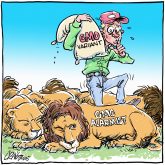AS THE clock ticked toward the end of the 1993 world trade talks and Canada was isolated in attempts to defend agriculture’s quantity-based quotas, there was deep suspicion in Canada’s supply managed sector that chief agricultural trade negotiator Mike Gifford wasn’t trying very hard.
Or if he was, his heart wasn’t in it.
Supply management leaders would meet regularly to vent that frustration privately. Some kind (and anonymous) soul in the industry would fax memos from the meetings to the Western Producer Ottawa bureau
news and they formed the basis of several stories about industry suspicions.
Read Also

High prices see cow-calf producers rushing to incorporate
Farm accountants are reporting a steady stream of cow-calf producers rushing to get their operations incorporated ahead of selling their calves this fall.
Gifford in Geneva kept up a brave front of championing Canada’s “balanced” position but privately he was furious about the stories and the industry suspicions, considering his position undermined.
It is 12 years later, and the retired trade negotiator last week revealed what he really thought in those days.
He thought that the industry-driven government decision to defend-till-the-end volume import controls and to resist conversion to tariffs was a disservice to the industry and Canada’s negotiators.
Long after industry leaders were told any deal would include tariffication, they continued to insist Canada not sign on, Gifford said.
The result, he believes, is that negotiators like himself had little credibility at the end and little ability to leverage concessions to help Canada’s farmers.
Now Gifford says the same thing is happening as the latest round of World Trade Organization talks careen toward a pivotal meeting in Hong Kong in December.
Supply management leaders insist there must be no cuts in over-quota tariffs agreed to in 1993. Almost all other countries say all tariffs must face cuts in any access deal.
It is Gifford’s controversial view that supply management could survive tariff cuts of up to 33 percent and still adjust and prosper. By refusing to budge or to let the government budge, industry leaders have “painted negotiators into an impossible corner.”
He says industry leaders are failing by refusing to be more flexible, by leading average dairy farmers to believe their no-cut policy can win and by painting an apocalyptic scenario abut what will happen if any cuts are allowed.
And the government is on too short a leash to be creative in winning some concessions for accepting small tariff cuts.
It is not an argument supply management leaders will welcome but they will have a difficult time ignoring it.
WTO negotiations must feel a bit like quicksand to them. Once in, it is almost impossible to clamber out.
Sector leaders are correct to insist real trade flows in some products can increase without tariff cuts but if 140 members or more of the 148-member WTO agree tariff cuts are the way to go, Canada is not going to be given an exemption.
It is true that in theory, Canada could scuttle any deal that includes over-quota tariff cuts because the WTO has a unanimity rule but is it realistic to imagine Canada would “walk away” in the face of powerful business sectors that want a deal?
Canada will not block a WTO deal just to preserve 200 percent plus tariffs on dairy products.
Count on it.
So what is supply management’s Plan B anyway?














